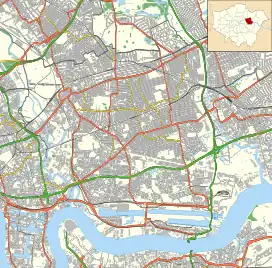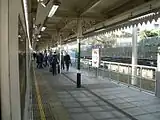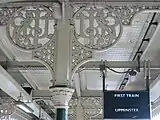East Ham tube station
East Ham is a London Underground station on High Street North in the East Ham neighbourhood of the London Borough of Newham in east London, England. The station is on the District line and Hammersmith & City line. The station was opened on 31 March 1858 by the London, Tilbury and Southend Railway on a new more direct route from Fenchurch Street to Barking. The large Edwardian station building was constructed to accommodate the electric District Railway services on an additional set of tracks opened in 1905. It has high and growing usage for a suburban station with 13.1 million entries and exits in 2010. It is in London fares zones 3 and 4.
| East Ham | |
|---|---|
.jpg.webp) Entrance to High Street North | |
 East Ham Location of East Ham in London Borough of Newham | |
| Location | East Ham |
| Local authority | London Borough of Newham |
| Managed by | London Underground |
| Number of platforms | 2 |
| Accessible | Yes[1] |
| Fare zone | 3 and 4 |
| London Underground annual entry and exit | |
| 2018 | |
| 2019 | |
| 2020 | |
| 2021 | |
| 2022 | |
| Railway companies | |
| Original company | London, Tilbury and Southend Railway |
| Pre-grouping | Midland Railway |
| Post-grouping | London, Midland and Scottish Railway |
| Key dates | |
| 31 March 1858 | Opened |
| 1902 | District line started |
| 1936 | Metropolitan line started |
| 1948 | Ownership transferred to British Railways |
| 1962 | London–Southend withdrawn |
| 1969 | Ownership transferred to London Transport |
| 1988 | Metropolitan line renamed Hammersmith & City line |
| Listed status | |
| Listing grade | II |
| Entry number | 1245066[7] |
| Added to list | 20 January 1999 |
| Other information | |
| External links | |
| WGS84 | 51.539°N 0.0516°E |
History
The London, Tilbury and Southend line from Bow to Barking was constructed east to west through the middle of the Parish of East Ham in 1858. Prior to the building of the line trains took a longer route via Stratford and Forest Gate to the north. The new line initially also had stations at Bromley and Plaistow, with Upton Park added as the next station to the west of East Ham in 1877. District line, then known as the District Railway, service began in 1902.[8]
The District line was electrified in 1905 over a second pair of tracks, and the service was cut back from Upminster to East Ham; the station then served as the eastern terminus, where passengers transferred to steam trains, until 1908 when electrification was extended to Barking. In 1936 the Metropolitan line service was introduced. In 1990 the station, along with other stations beyond Aldgate East, was transferred to the new Hammersmith & City line.[8] A short spur line to Woodgrange Park was opened in 1894 and was closed in 1958.[9]
Accidents and incidents
- On 12 November 1959, a passenger train overran signals and was in a rear-end collision with another standing at the station. Thirteen people were injured.[10]
- On 14 February 1990, an empty stock train formed of a Class 305 and a Class 308 electric multiple unit was derailed.[11]
Design
The station has two platforms, one for each direction. Much of the original Victorian station architecture has been retained and some restoration work was carried out during 2005. The disused platforms of the Fenchurch Street to Southend services, withdrawn in 1962, are to the south of the current platforms. A disused bay platform on the northern side of the station, closed in 1958, connected to the Tottenham and Forest Gate Railway (now the Gospel Oak to Barking line) via a curve.[12]
Services
Eastbound
- 12tph to Upminster (District line)
- 3tph to Barking (District line)
- 6tph to Barking (Hammersmith & City line)
Westbound
- 6tph to Richmond (District line)
- 6tph to Ealing Broadway (District line)
- 3tph to Wimbledon (District line)
- 6tph to Hammersmith (Hammersmith & City line)
| Preceding station | Following station | |||
|---|---|---|---|---|
| Upton Park towards Hammersmith |
Hammersmith & City line | Barking Terminus | ||
| Upton Park | District line | Barking towards Upminster | ||
| Former services | ||||
| Upton Park towards Hammersmith |
Metropolitan line Hammersmith branch (1936-1990) |
Barking Terminus | ||
| Disused railways | ||||
| Terminus | Tottenham and Forest Gate Railway | Woodgrange Park | ||
| Historical railways | ||||
| Upton Park | British Rail Eastern Region London, Tilbury and Southend line |
Barking | ||
Gallery
 District line train at the eastbound platform.
District line train at the eastbound platform. 'Lightbox' destination display and canopy support detail 'LTSR' on eastbound platform.
'Lightbox' destination display and canopy support detail 'LTSR' on eastbound platform. Close-up of 'LTSR' detail on canopy support.
Close-up of 'LTSR' detail on canopy support.
References
- "Step free Tube Guide" (PDF). Transport for London. April 2021. Archived (PDF) from the original on 15 May 2021.
- "Station Usage Data" (CSV). Usage Statistics for London Stations, 2018. Transport for London. 23 September 2020. Archived from the original on 14 January 2023. Retrieved 11 October 2023.
- "Station Usage Data" (XLSX). Usage Statistics for London Stations, 2019. Transport for London. 23 September 2020. Archived from the original on 9 November 2020. Retrieved 9 November 2020.
- "Station Usage Data" (XLSX). Usage Statistics for London Stations, 2020. Transport for London. 16 April 2021. Retrieved 1 January 2022.
- "Station Usage Data" (XLSX). Usage Statistics for London Stations, 2021. Transport for London. 12 July 2022. Retrieved 7 September 2022.
- "Station Usage Data" (XLSX). Usage Statistics for London Stations, 2022. Transport for London. 4 October 2023. Retrieved 10 October 2023.
- Historic England. "East Ham Underground Station (1245066)". National Heritage List for England. Retrieved 12 November 2012.
- Rose, D., The London Underground: A diagrammatic history, (1999)
- Chronology of London Railways by H.V.Borley page 20
- Earnshaw, Alan (1993). Trains in Trouble: Vol. 8. Penryn: Atlantic Books. p. 32. ISBN 0-906899-52-4.
- McCrickard, John P (6 October 2016). "January 1990 to December 1990". Network South East Railway Society. Archived from the original on 26 June 2018. Retrieved 26 June 2018.
- "East Ham Station (5) | the Newham Story". Archived from the original on 15 March 2013. Retrieved 17 March 2013.
- "Buses from East Ham Station and Town Hall" (PDF). TfL. 21 May 2022. Archived (PDF) from the original on 20 May 2022. Retrieved 20 May 2022.